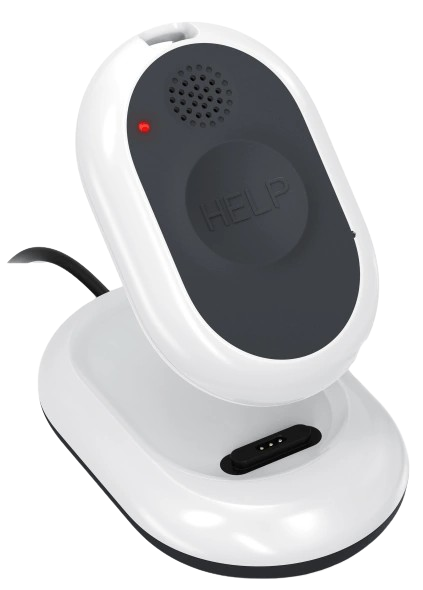Wisconsin's workforce spans a wide array of industries where employees often work alone or in remote locations—such as agriculture, utilities, maintenance, healthcare, and manufacturing. These lone workers, who perform duties without nearby coworkers or direct supervision, are exposed to greater risk in emergency situations. Employers in Wisconsin are responsible for assessing these risks and ensuring appropriate safeguards are in place.
Wisconsin does not operate its own OSHA-approved occupational safety and health program, meaning the state follows federal OSHA standards for private-sector and most public-sector worker safety. However, the Wisconsin Department of Workforce Development (DWD) and the Wisconsin Department of Safety and Professional Services (DSPS) oversee broader labor and safety-related matters that may indirectly relate to lone worker scenarios.
On This Page
Our Guide To Lone Worker Safety Policy And Legislation In Wisconsin
Because Wisconsin falls under federal OSHA jurisdiction, all workplace safety requirements—including those that impact lone workers—are governed by federal regulations. OSHA's General Duty Clause mandates that employers must provide a workplace free from recognized hazards, which extends to working conditions involving employee isolation.
Although OSHA does not have a regulation that explicitly defines or governs "lone work," employers are expected to manage hazards associated with remote or unsupervised tasks. This includes ensuring adequate communication, emergency preparedness, and hazard-specific controls for workers performing duties alone.
At the state level, agencies like DWD and DSPS enforce worker protections, licensing, and professional standards that may intersect with certain lone worker occupations, particularly in healthcare and construction.
How Wisconsin Defines A Lone Worker
There is no formal legal definition of “lone worker” in Wisconsin labor laws or OSHA standards. However, the term is commonly used to describe workers who operate without immediate supervision or coworkers present.
In Wisconsin, lone workers are frequently found in roles such as:
- Agricultural fieldwork and equipment operation
- Home healthcare services
- Utility or telecom repairs in rural areas
- Janitorial and security staff working late or overnight shifts
- Delivery drivers and field sales agents
- Maintenance personnel in manufacturing or municipal settings
Because these individuals may be unable to summon help quickly in an emergency, it is vital that employers assess and mitigate risks specific to their roles and locations.
Employing A Lone Worker In Wisconsin
Employers with lone workers in Wisconsin are encouraged to adopt a risk-based approach to workplace safety. While no standalone regulation targets lone working, federal OSHA still expects that job-specific hazards—including those tied to isolation—are properly managed.
Best practices include:
- Risk Assessments: Identify potential dangers associated with working alone, such as falls, medical emergencies, or environmental exposure
- Communication Systems: Equip employees with mobile phones, radios, or lone worker safety devices
- Scheduled Check-Ins: Implement routine check-ins manually or through automated systems to confirm safety
- Training: Provide employees with the skills and knowledge to handle emergencies when help is not immediately available
- Written Procedures: Develop emergency protocols and response plans specifically for lone work environments
These steps contribute to a safer workplace and help ensure compliance with federal OSHA expectations.
Learn How You Can Protect Your Employees With Loneworker.com

With Loneworker.com you can be equipped with the knowledge and the means to protect your employees and protect your business. Contact us today to learn more about how Loneworker.com can protect you and your employees.
How The Safe Lone Worker App Can Protect Wisconsin Lone Workers And Employers
The Safe Lone Worker app gives Wisconsin employers a practical solution for managing lone worker safety. Features such as real-time GPS tracking, emergency alerts, fall detection, and automatic check-ins allow supervisors to maintain awareness and respond quickly to any incidents.
Whether your team works in the field, in clients’ homes, or in isolated industrial areas, this technology strengthens your safety posture and demonstrates your commitment to protecting employees under OSHA regulations.
Wisconsin Lone Worker Policies
Since Wisconsin does not administer its own OSHA-approved State Plan, all occupational safety laws for private employers are enforced by federal OSHA. While OSHA does not provide a specific standard for lone workers, employers are still obligated to address the hazards of working alone under the General Duty Clause.
For the most accurate guidance, employers should consult OSHA’s official website and explore its resources for hazard identification, training, and safety planning. This article is for general informational purposes and does not replace legal or regulatory consultation.
Wisconsin Lone Worker Resources
OHS Contact Centre
- 1-866-415-8690
CDC / NIOSH
- 800-232-4636

Affordable Monitoring For Lone Workers In Wisconsin

-
 Monitoring Your Employees' Safety
Monitoring Your Employees' Safety
-
 GPS Tracking And Monitoring
GPS Tracking And Monitoring
-
 Man Down Panic Alerts
Man Down Panic Alerts
-
 24/7 Protection Anywhere
24/7 Protection Anywhere
Lone Worker Legislation
Lone Worker Safety Policies And Legislation By State
-
 Alabama State Safety Policies And Legislation
Alabama State Safety Policies And Legislation
-
 Alaska State Safety Policies And Legislation
Alaska State Safety Policies And Legislation
-
 Arizona State Safety Policies And Legislation
Arizona State Safety Policies And Legislation
-
 Arkansas State Safety Policies And Legislation
Arkansas State Safety Policies And Legislation
-
 California State Safety Policies And Legislation
California State Safety Policies And Legislation
-
 Colorado State Safety Policies And Legislation
Colorado State Safety Policies And Legislation
-
 Connecticut State Safety Policies And Legislation
Connecticut State Safety Policies And Legislation
-
 Delaware State Safety Policies And Legislation
Delaware State Safety Policies And Legislation
-
 Florida State Safety Policies And Legislation
Florida State Safety Policies And Legislation
-
 Georgia State Safety Policies And Legislation
Georgia State Safety Policies And Legislation
-
 Hawaii State Safety Policies And Legislation
Hawaii State Safety Policies And Legislation
-
 Idaho State Safety Policies And Legislation
Idaho State Safety Policies And Legislation
-
 Illinois State Safety Policies And Legislation
Illinois State Safety Policies And Legislation
-
 Indiana State Safety Policies And Legislation
Indiana State Safety Policies And Legislation
-
 Iowa State Safety Policies And Legislation
Iowa State Safety Policies And Legislation
-
 Kansas State Safety Policies And Legislation
Kansas State Safety Policies And Legislation
-
 Kentucky State Safety Policies And Legislation
Kentucky State Safety Policies And Legislation
-
 Louisiana State Safety Policies And Legislation
Louisiana State Safety Policies And Legislation
-
 Maine State Safety Policies And Legislation
Maine State Safety Policies And Legislation
-
 Maryland State Safety Policies And Legislation
Maryland State Safety Policies And Legislation
-
 Massachusetts State Safety Policies And Legislation
Massachusetts State Safety Policies And Legislation
-
 Michigan State Safety Policies And Legislation
Michigan State Safety Policies And Legislation
-
 Minnesota State Safety Policies And Legislation
Minnesota State Safety Policies And Legislation
-
 Mississippi State Safety Policies And Legislation
Mississippi State Safety Policies And Legislation
-
 Missouri State Safety Policies And Legislation
Missouri State Safety Policies And Legislation
-
 Montana State Safety Policies And Legislation
Montana State Safety Policies And Legislation
-
 Nebraska State Safety Policies And Legislation
Nebraska State Safety Policies And Legislation
-
 Nevada State Safety Policies And Legislation
Nevada State Safety Policies And Legislation
-
 New Hampshire State Safety Policies And Legislation
New Hampshire State Safety Policies And Legislation
-
 New Jersey State Safety Policies And Legislation
New Jersey State Safety Policies And Legislation
-
 New Mexico State Safety Policies And Legislation
New Mexico State Safety Policies And Legislation
-
 New York State Safety Policies And Legislation
New York State Safety Policies And Legislation
-
 North Carolina State Safety Policies And Legislation
North Carolina State Safety Policies And Legislation
-
 North Dakota State Safety Policies And Legislation
North Dakota State Safety Policies And Legislation
-
 Ohio State Safety Policies And Legislation
Ohio State Safety Policies And Legislation
-
 Oklahoma State Safety Policies And Legislation
Oklahoma State Safety Policies And Legislation
-
 Oregon State Safety Policies And Legislation
Oregon State Safety Policies And Legislation
-
 Pennsylvania State Safety Policies And Legislation
Pennsylvania State Safety Policies And Legislation
-
 Rhode Island State Safety Policies And Legislation
Rhode Island State Safety Policies And Legislation
-
 South Carolina State Safety Policies And Legislation
South Carolina State Safety Policies And Legislation
-
 South Dakota State Safety Policies And Legislation
South Dakota State Safety Policies And Legislation
-
 Tennessee State Safety Policies And Legislation
Tennessee State Safety Policies And Legislation
-
 Texas State Safety Policies And Legislation
Texas State Safety Policies And Legislation
-
 Utah State Safety Policies And Legislation
Utah State Safety Policies And Legislation
-
 Vermont State Safety Policies And Legislation
Vermont State Safety Policies And Legislation
-
 Virginia State Safety Policies And Legislation
Virginia State Safety Policies And Legislation
-
 Washington State Safety Policies And Legislation
Washington State Safety Policies And Legislation
-
 West Virginia State Safety Policies And Legislation
West Virginia State Safety Policies And Legislation
-
 Wisconsin State Safety Policies And Legislation
Wisconsin State Safety Policies And Legislation
-
 Wyoming State Safety Policies And Legislation
Wyoming State Safety Policies And Legislation







